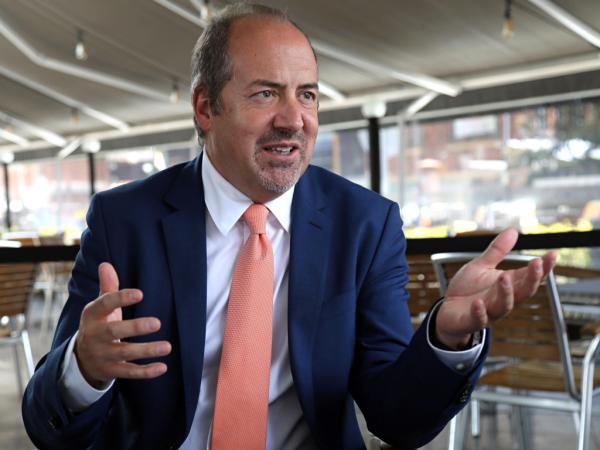The Organization for Economic Cooperation and Development (OECD)presented its most recent analysis of the country’s economic situation and there it warns that the slowdown continues unabated, which is why it is urgent to strengthen investor confidence, so that private capital gradually returns, while it issued an alert regarding the high levels of informality, which for them, are related to the poor performance of the GDP.
Álvaro Pereira, chief economist for Latin America for this organization, spoke with Portafolio about the growth, inflation and debt projections for Colombia, while also leaving on the table his observations regarding the labor reform and the financing law, emphasizing that beyond generating new taxes, the existing ones must be managed, both in terms of collection and execution.
For reading: Powdered milk from the US will be charged a ‘permit’ to enter Colombia
How do you see the economic dynamics?
The Colombian economy had a difficult time like all others in the world during the pandemic, but it has recovered quickly afterwards and, because of this, there was a rather marked slowdown last year and we are just beginning to see an upturn again. That said, we expect Colombia to grow 1.8% this year and next year, in 2025, 2.8%, close to 3%. Everything depends on the international and national situation.
Here it should be noted that one of the challenges that many countries have had in the last two years has been the rise in inflation, which has had a very large impact on households, because there was a significant reduction in people’s real wages and in the purchasing power that they can have. This was something that had to be done to stabilise the economy and is currently yielding results.
Has the Bank of the Republic done things right?
This year we are forecasting inflation of around 5.7% and next year around 3.6%. But we are already very close to the target range of the Central Bank, which we must congratulate because clearly this was one of Colombia’s challenges and it has managed the crisis correctly.
However, there is still much to be done, especially with an important issue for the country, such as the labor sector. We have unemployment that is still around 10%, but we still have informality that is brutal, too large and in which there have been some improvements, but there must be even more in the coming times.
Are there good levels of growth?
Let’s start with the fact that 2.8% is a more recommendable rate than the current one. The point is that Colombia has the potential to grow more. A country like this can and should grow 5% or 6% a year, but to do so you have to do two things. First, you have to increase investment. Here we can take estimates such as those from Fedesarrollo, which warn that a possible GDP rebound could be higher if investment recovers.
More news: Informality and public spending in Colombia are a concern for the OECD
Here we must add that the Government’s plans to reindustrialize and diversify the economy make sense because Colombia has the potential to do much more in terms of industry, much more in terms of tourism, even in pending areas such as agriculture. Through investment, we also reduce informality.
Is informality affecting?
If informality is not reduced, this means that there is a part of the economy that is not working, that has a potential that is not yet fully exploited. That is why increasing the formalization rates of workers is an important part of stimulating Colombia’s potential. Let us not overlook the fact that in the case of women, there are very low participation rates at the OECD level.
Álvaro Pereira, Chief Economist of the OECD.
CEET Photo – Milton Diaz.
The country is improving. The last two decades have clearly been decades of progress, but much more can be done and that is why reforms are essential to address the challenges that Colombia has to face.
Does labor reform help?
This reform has positive aspects, including in terms of collective bargaining. We think that the most important thing is that increasing the costs of formalisation will have an impact on formalisation. And that is why when we say that, for example, some costs of formalising workers are still very high, that does not help to combat the informality that exists in the market.
We believe that the reform has positive aspects, such as greater protection for workers who are already formal workers, but at the same time this can have an impact and we must be very careful in terms of informal employment and we must put policies in place so that this reform, if it goes ahead, mitigates the impact on informality.
Read also: Why should drilling at Uchuva-2 continue? This is what Acipet explains
Is there good public spending?
The first thing to say here is that we think it is good that this Government, as well as previous ones, is respecting the fiscal rule and the debt anchor levels. That has not changed and sends a positive message. Here we can only say that we must respect the limits and have discipline in the use of resources.
Now, moving on to tax collection, we believe that although some exemptions have already been eliminated in the last tax reform, there are still more that we believe can be worked on to ensure that tax collection increases. Colombia has had 21 tax reforms in the last 20 years and that is why it is worth remembering that, as has happened throughout the region, sometimes there are not real tax reforms, but tax increases.

Indicators
PHOTO: iStock
Should spending be cut?
One can make a tax reform to increase revenues, but one has to make sure that those revenues are spent in the best way, because in the long run it will mean that the collection will have to be increased to a lesser extent or that the money can be used in other areas that are not currently being reviewed. We are going more towards the efficiency of spending.
As? Lowering subsidies of all kinds, as the Government has begun to do with dieselThen we can look at subsidies for public services, which are very poorly targeted and basically go to the rich. There we can start with targeting, so that aid reaches those who really need it. Mind you, it is not about ending them, but about ensuring that they are used well.

















